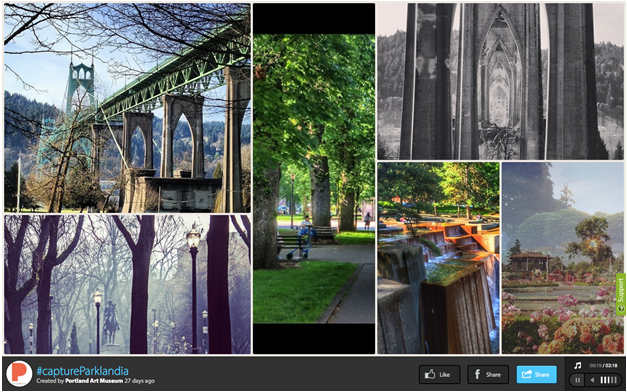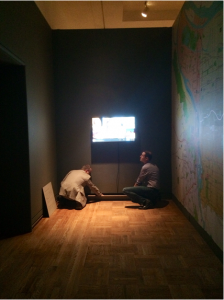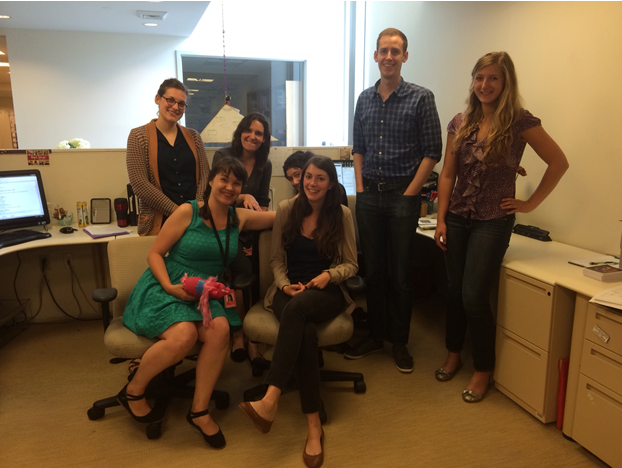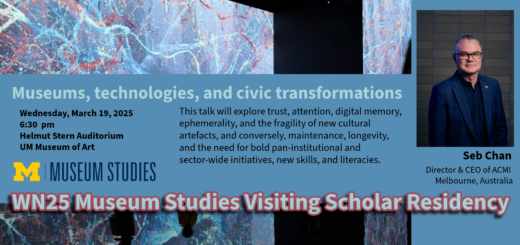A Letter from Portland – Justin Meyer

This Letter from the Field was shared with us by Justin Meyer, MSP12.
I can’t believe my practicum experience is almost over. Who knew I would accomplish and learn so much in three short months?
My mentor for the past three months, Kristin Bayans, is the Portland (Oregon) Art Museum’s ‘Interpretive Media Specialist’ and part of the Education Department. When she arrived at the Portland Art Museum (PAM) seven months ago, she wanted to break ground on interpretive media exhibition projects that the museum had never before considered. When she agreed to supervise me as her intern, she tasked me with helping her design and implement the museum’s first-ever engagement and exhibition project using social media.
This project, entitled #captureParklandia, uses the social media network Instagram to reach audiences outside PAM’s traditional sphere of influence and engages them with the content of PAM’s special traveling exhibit, The Art of the Louvre’s Tuileries Garden. CaptureParklandia displays crowdsourced Instagram images of Portland Parks at the end of the Tuileries exhibition, inspiring visitors to experience Portland’s parks through the historical and political lens of Paris’s famous Tuileries Garden. Images of Portland parks are presented in a dynamic digital gallery, as well as on twelve Portland Park trading cards that visitors can take with them. The trading cards have numbers on them that correspond to the numbers on a huge wall map of Portland, helping visitors orient themselves with respect to each park’s location in the city. Several hours of visitor observations have revealed that these three different ways of interpreting the Instagram park images (the digital gallery, the large wall map, and the trading cards) lead to lingering discussions between people in the gallery about Portland’s parks. The use of Instagram has also taken the conversation about urban park space to an online audience of hundreds of thousands that lie outside the walls of the museum, as evidenced by over 1200 tagged photos (and counting), thousands of comments, and hundreds of thousands of online views on Instagram.
CaptureParklandia is the product of many of hours of research, meetings, design work, outreach, and physical labor, all of it done in collaboration with partner organizations and multiple museum staff. The first day in my internship, I was calling social media specialists at the Smithsonian, San Francisco MOMA, and the Getty on behalf of the Portland Art museum to research how other museums were using Instagram — quite a responsibility for someone who just stepped in the door! Kristin also had me managing the collaboration with our project partners, the Portland Parks Foundation, to ensure that both PAM’s and the Portland Parks Foundation’s goals were being addressed in CaptureParklandia. PAM had virtually no financial resources dedicated to the project, so nearly all aspects of the project (collecting Instagram images of Portland parks, displaying these images in a gallery, tracking where these images came from, creating an interactive map with these parks) had to be implemented at no cost. Luckily, I was able to find plenty of web applications and widgets that could perform the functions we wanted for free.
Even though I had a decent plan of how we would be using the (free) technology, CaptureParklandia still needed participation of people on Instagram to be successful. This led Kristin and me to a pub popular with the Portland Instagram community one day after work to encourage participation among the most active Instagrammers in Portland. I didn’t realize how important socializing over beer would be to our project — after our visit to the pub, our project had hundreds of crowdsourced images in two days!
 That is not to say that working on CaptureParklandia was a leisurely experience. One particularly chaotic moment in the project was learning that a new partner organization (Portland Parks and Recreation) would like to cover the costs of printing 120,000+ park trading cards with some of our project’s Instagram images (the brilliant idea of PAM’s Art Director). We heard this news one week before the exhibition opened, leaving us only three days to design the cards and get Instagram users’ permission to use their images! With the assistance of Kristin and PAM’s Art Director, I managed to get a proof of the cards in by the deadline, along with everyone’s signed consent forms. The last few days before the exhibition opened were also filled with some physical labor, such as working on my hands and knees with PAM’s Art Director to get our display screen connected in the gallery.
That is not to say that working on CaptureParklandia was a leisurely experience. One particularly chaotic moment in the project was learning that a new partner organization (Portland Parks and Recreation) would like to cover the costs of printing 120,000+ park trading cards with some of our project’s Instagram images (the brilliant idea of PAM’s Art Director). We heard this news one week before the exhibition opened, leaving us only three days to design the cards and get Instagram users’ permission to use their images! With the assistance of Kristin and PAM’s Art Director, I managed to get a proof of the cards in by the deadline, along with everyone’s signed consent forms. The last few days before the exhibition opened were also filled with some physical labor, such as working on my hands and knees with PAM’s Art Director to get our display screen connected in the gallery.
Through the leisure/chaos/physical labor working as a full-time staff member at PAM, I had many other valuable experiences. I learned quite a bit about how museums function and the internal tensions between departments that have different goals (particularly the tension between object-centered and people-centered goals that I learned about in the Museum Studies proseminar course). I had the opportunity to present CaptureParklandia to an all museum staff meeting, attended by the museum’s management and Director. I even talked one-on-one with PAM’s Director of Education, its Chief Curator, and its Director at various times about my research and experience working at the museum. Perhaps most fun of all, I joined my Education Department colleagues on plenty of coffee outings, birthday parties, and happy hours.
The project I managed during my practicum, CaptureParklandia, is the first project of its kind for the museum, and has exceeded all of our expectations. Of course, success wouldn’t have been possible if not for the collaborative efforts of outside organizations partnering with the museum (the Portland Parks Foundation and Portland Parks and Recreation), and the mentoring of a multitude of PAM’s staff (Kristin Bayans, Stephanie Parrish, Mike Murawski, Michael Smith, Beth Heinrich, and Bruce Guenther).
Lastly, this uniquely immersive museum experience would not have been possible without the Museum Studies Program. The Museum Studies proseminar course prepared me for the kinds of challenges I would face in the museum, such as completing projects with few financial resources and negotiating the tensions of object-centered goals and people-centered goals. Also, as the Museum Studies Program’s third Dryfhout Intern, I am grateful for the funding I received from MSP and from a generous gift to the program made by Museum Practice Program alumnus John Dryfhout (thank you Mr. Dryfhout!) that made it possible for me to complete this internship without having to support myself with an additional job.
I have had a wonderful practicum experience at the Portland Art Museum; I contributed to the mission of one of the United States’ oldest art museums, gleaned invaluable information for my doctoral research on art museums and neighborhoods, made valuable professional connections, and forged lasting friendships.
The name ‘Parklandia’ comes from the branding of the Portland Parks Foundation (their website is parklandia.org) and references the popular cult television show Portlandia, which has made the city of Portland a part of mainstream culture in the U.S and globally.



